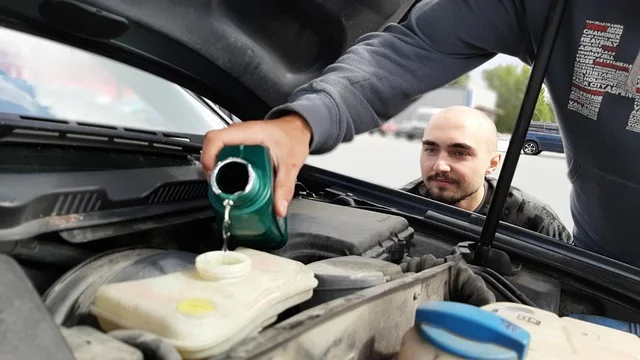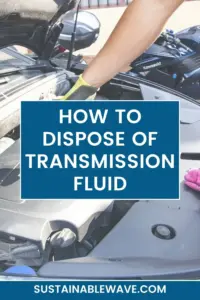When it comes to car maintenance, few think about what to do with the waste products. One such product is transmission fluid. So, how do you dispose of transmission fluid in an eco-friendly and responsible way?
To dispose of transmission fluid, collect it in a sealable container, then take it to a local hazardous waste center or auto-part store that accepts used fluids for recycling.
Let’s dive right in as there is a bit more you can do to make it as easy as possible for you!
Transmission Fluid Disposal

Ever wondered why proper disposal is such a big deal? Well, disposing of transmission fluid, or any automotive fluid, responsibly prevents environmental harm. Think of it as a chain reaction. When these fluids seep into the ground, they can contaminate water sources, harming aquatic life and our drinking water.
Imagine pouring your old transmission fluid down the drain or in your backyard. Harmless? Think again! These fluids contain harmful chemicals that are hazardous to both the environment and public health. They can poison animals, plants, and aquatic ecosystems.
Now, that’s not a legacy any of us would like to leave behind, right?
5 Steps on How to Dispose Of Transmission Fluid
Properly disposing of transmission fluid requires more than just getting rid of it. You need a systematic approach that ensures safety, environmental preservation, and legal compliance.
By following the steps outlined below, you can ensure responsible disposal without any headaches.
Step 1: Gather Necessary Materials
Before you get started, you need the right tools for the job. Let’s break down what each of these materials does:
- A Large Drain Pan or Container: This is where you’ll initially collect the transmission fluid. Make sure it’s clean and free from any residue. An ideal pan should be large enough to contain any fluid that spills during the draining process.
- Funnel: A funnel ensures you can transfer the fluid from the pan to the containers without spills. Accidental spills can be harmful to the environment and even incur fines in some jurisdictions.
- Sealable Containers: These are crucial for transporting the fluid safely. Make sure the containers are clean and sealed tightly. Recycled motor oil containers or dedicated containers designed for waste fluids are ideal.
- Gloves and Safety Goggles: Transmission fluid can be harmful if it comes into contact with your skin or eyes. Always prioritize safety first!
Step 2: Contain and Seal the Fluid
Once you’ve drained the transmission fluid into the pan, you’ll need to transfer it for storage and transport. Carefully pour the fluid through the funnel into your sealable containers. Ensure you seal the containers tightly to prevent any leaks.
If any spills occur, clean them up immediately with an absorbent material like cat litter, then dispose of the material properly.
Step 3: Find Local Collection Centers
Not all places accept transmission fluid, so you need to find those that do:
- Local Hazardous Waste Collection Centers: Many towns and cities have designated collection days or centers where residents can drop off hazardous waste.
- Auto-Part Stores: Some of these stores offer fluid recycling services. Call ahead to confirm.
- Online Resources: Websites, apps, or local community boards often list recycling centers and their accepted items.
Tips for Finding Centers
- Call your local municipality or waste management facility.
- Check online directories or mobile apps focused on recycling.
- Reach out to nearby auto repair shops.
Step 4: Transport Safely
Safety doesn’t stop once the fluid is in the containers:
- Secure Containers: Ensure that the containers are upright and won’t tip over. Use boxes or other items to keep them in place.
- Avoid Mixing Fluids: If you’re also disposing of other fluids, keep them in separate containers. Mixing can make recycling difficult or impossible.
- Drive Carefully: Even if containers are sealed, sharp turns or sudden stops can cause spills.
Step 5: Recycle or Reuse
Upon reaching the collection center:
- Recycling: Many centers have facilities to clean and process used transmission fluid, allowing it to be reused.
- Reuse: If you’re a professional, you might have the equipment to clean and reuse transmission fluid yourself, though it’s generally recommended to let specialists handle it.
Alternative Methods for Disposal
Apart from the traditional disposal methods at recycling centers or auto-part stores, there are several alternative options you can consider.
Each of these methods has its advantages, ensuring that your transmission fluid doesn’t harm the environment or go to waste.
Donating to Auto Repair Shops
While it may sound unusual, some auto repair shops are willing to accept old transmission fluid. Here’s why:
- Professional Equipment: Auto shops often have access to professional-grade equipment that can clean and filter used transmission fluid, rendering it usable once more.
- Cost-Efficient: For them, reprocessing old transmission fluid can be more cost-effective than always buying new. By donating, you’re essentially providing them with raw materials.
- Eco-friendly: Shops that accept used fluids often adhere to environmentally friendly practices, ensuring the fluid won’t end up contaminating the surroundings.
- Tip: Always call ahead to confirm if the shop accepts old transmission fluid. Some might even offer a small monetary incentive!
Community Collection Events
Many communities are becoming environmentally conscious and organize events specifically for collecting hazardous wastes, including transmission fluid.
- Scheduled Events: These are often scheduled annually or bi-annually. Check your local community’s calendar or website.
- Safe Disposal: These events are usually backed by the local government, ensuring that the collected waste will be disposed of responsibly.
- Awareness: Participating in such events also raises awareness among neighbors and friends, promoting a community-wide eco-friendly initiative.
Using for Alternative Purposes
Some industries can utilize old transmission fluid in ways other than in vehicles:
- Industrial Lubricants: Transmission fluid can be treated and used as a base for certain industrial lubricants.
- Heating: In certain setups, especially in industrial spaces, used transmission fluid can be burned as a source of heat. However, this requires specific equipment to ensure it burns efficiently and cleanly.
- Note: If you’re considering repurposing the fluid, always consult with professionals. DIY reuse without proper knowledge can lead to safety hazards or reduce the efficiency of the fluid in its new role.
Schools or Educational Institutions
Some technical or vocational schools that offer automotive courses might accept used transmission fluid:
- Practical Training: Schools can use the fluid for training purposes, demonstrating to students how to handle and process used automotive fluids.
- Support Education: By donating, you’re not just disposing of the fluid but also contributing to the education of future automotive professionals.
- Safety First: Always ensure the institutions have the proper facilities to handle and store the fluid safely.

I’m Thomas, the owner of SustainableWave. Passionately promoting a sustainable planet. With experience in various eco-roles, I’ll share green tips, sustainability hacks, and personal eco-journeys on my blog.






